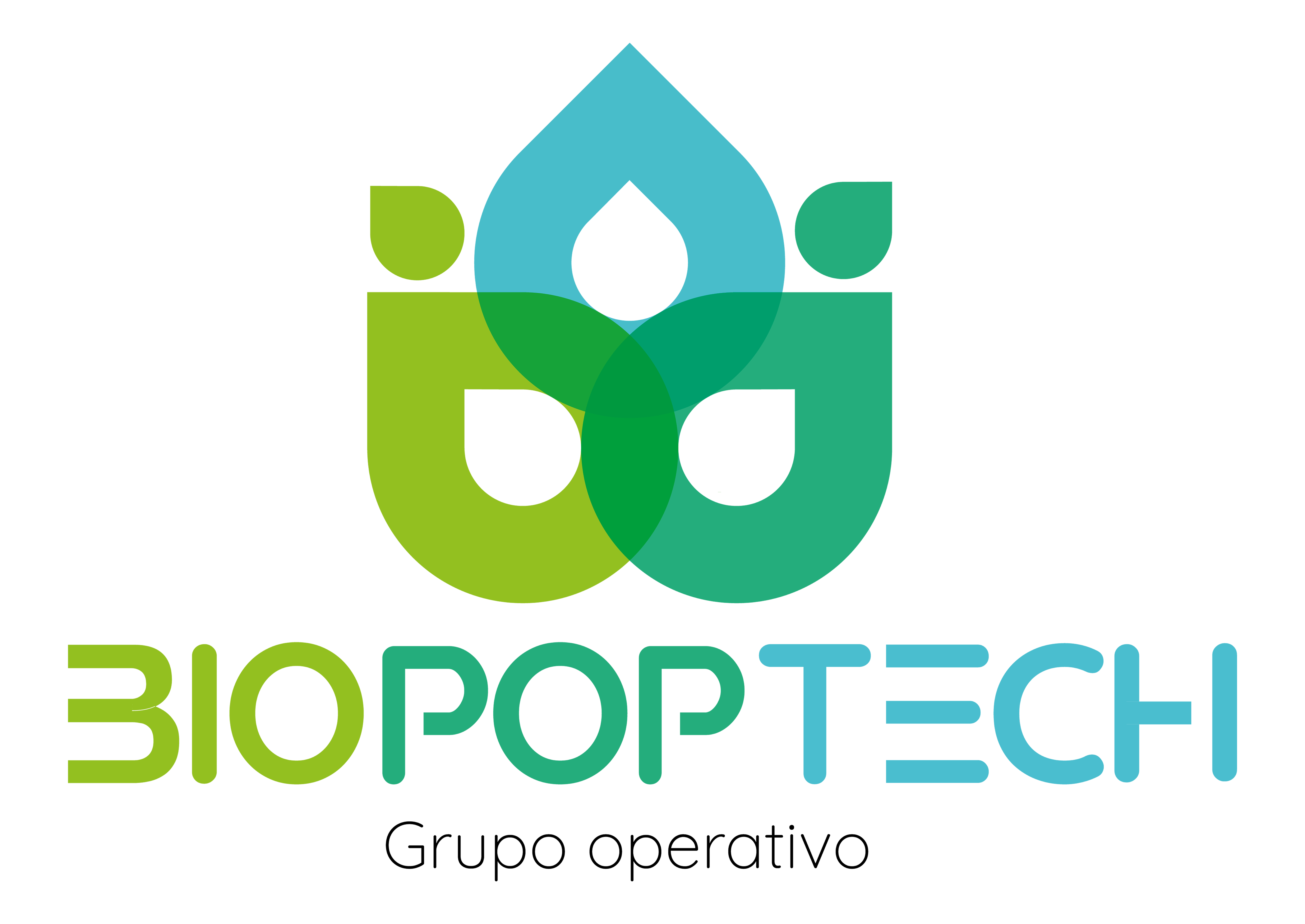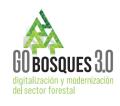
BIOPOPTECH Operational Group: Promotion of poplar cultivation and the cascading use of its wood towards high-value-added technological products
- Type Operational group
- Status Filled
- Execution 2022 -2025
- Assigned Budget 596.871,76 €
- Scope Supraautonómico
- Autonomous community Andalucía; Castilla y León; Galicia; Navarra, Comunidad Foral de; Rioja, La
- Main source of financing CAP 2014-2020
- Project website https://gobiopoptech.es/
Through an innovative study with 45 poplar plots (15 clonal + 30 productive), BIOPOPTECH promotes the optimization of production performance in the manufacture of different wood products (LSL, plywood) and the development of ICTs for the optimization and promotion of the resource, based on the clone and other variables.
- To understand clonal, environmental and dendrometric influences on the technological quality of poplar wood.
- Optimize resource use through proper characterization of raw materials in the production-processing chain
- Integration of ICT results for technological allocation in poplar wood and optimization of resource utilization
- Promoting poplar plantations and optimizing their economic performance by incorporating sustainable forest management certification.
- Determination of potential clones for use in Spain based on the characteristics of the environment
- New clonal optimization system from the mechanical characterization of plywood and LSL (Laminated Strand Lumber) board in different clones
- Mobile ICT tools for assigning technological quality and a web-based visualization tool for owners to plant the optimal clone in each area.
- Group certification of sustainable forest management for small poplar grove owners and development of the "Gracias al Chopo" compensation system
R1- Determination of potential clones for use in Spain based on the characteristics of the environment.
Spanish poplar production is based on five clones: I-214 (56.2%), Beaupré (13.5%), Raspalje (10.1%), Unal (8.8%), and MC (5.7%). This low clonal diversity represents a high risk of the negative effects of climate change (pests, diseases, or increased abiotic stress). Within the framework of GO BIOPOPTECH, the productive and technological potential of 17 new clones has been evaluated against different climatic and soil variables. The results indicate that the new clones AF4, HOOGVORST, AF13, ALERMO, GUARDI, and DIVA are potentially more productive than clone I-214, the most widely planted clone in Spain. Based on these results, predictive models of the productivity and technological suitability of the wood from these clones have been developed, which have been incorporated into an online viewer (https://visor.gobiopoptech.es/). This tool allows current and potential farmers to select the clone best suited to their property by entering their property's cadastral data and soil properties, which are obtained through a simple laboratory analysis.
R2- New tools for assigning the technological properties of the wood of each clone.
The technological properties of wood determine its industrial use. In the case of poplar, it is interesting to integrate the characterization of these properties using non-destructive methods (sonic and NIR methodology) into the clonal selection process, especially wood stiffness (dynamic modulus of elasticity) and density. This result includes work carried out in 17 clonal trials and 14 production plots. In these plots, data on growth, stem shape, and technological properties of the wood were collected using non-destructive technologies.
The results show that dry, warm environments located at low altitudes above sea level, as well as calcium-rich soils with low pH and a sandy texture, increase the dynamic modulus of elasticity, or wood stiffness, of all clones. In contrast, the basic density of poplar wood is not affected by environmental variables, demonstrating high genetic control. In other words, poplar wood density is particularly clone-dependent. The new clones AF4 and AF13 have density values similar to clone I-214, while the clones GUARDI and HOOGVORST are similar to the current clones Raspalje, Beuapre, and Unal.
R3- New clonal optimization system based on the mechanical characterization of plywood in different clones.
The physical and mechanical properties of wood, such as modulus of elasticity (MOE), modulus of rupture (MOR), and density, are essential for optimizing the stiffness and mechanical properties of plywood panels.
Within the framework of GO BIOPOPTECH, the MOE, MOR, and density of plywood from the most widely planted clones, I-214, Beaupre, Raspalje, Unal, and MC, were evaluated according to the UNE-EN 789:2006 standard. The wood was obtained from productive plots of each clone, aged between 14 and 16 years. In all cases, the wood obtained from each portion of the trees was identified and kept separately: first trunk (0.3 to 3.5 m), second trunk (3.5 to 7 m), third trunk (over 7 m tall), and stump (part of the trunk with a diameter less than 22 cm). The plywood panels were manufactured according to the clone and the position of the wood within the tree.
The results indicate that both the MOE and MOR are higher in the Beaupré, Raspalje, and MC clones than in the I-214 and Unal clones. In all cases, and especially for the MOE, the second log (3.5 to 7 m) shows significantly higher values than the wood from the rest of the tree. Based on these results, it is possible to manufacture poplar plywood with structural characteristics through correct selection of the clone (Raspalje, Beaupré, or MC) and the different logs.
R4- New clonal optimization system based on the mechanical characterization of LSL (Laminated Fiberboard) in different clones.
In order to increase added value throughout the poplar production chain, work was carried out on the physical and mechanical characterization of Laminated Fiberboard (LSL) produced with wood from the most widely planted clones in Spain: I-214, Unal, MC, Raspalje, and Beaupré. LSL is an engineered wood product manufactured from logs from the upper trunks of trees with a diameter less than 22 cm. The logs were obtained from different production plots, and traceability from the forest to the industry was guaranteed. Six LSL samples were manufactured for each clone and plot. The samples were tested according to UNE-EN 408:2003 to obtain the modulus of elasticity (MOE) and modulus of rupture (MOR). Density was evaluated according to UNE-EN 408:2004 to obtain the average value of the entire sample. As with plywood, the Raspalje clone showed the highest values, differing significantly from the other clones. The results indicate that, with very low-quality wood from the upper part of trees, which is generally used for chipping or biomass, it is possible to obtain a product with excellent structural performance that, depending on the clone used, can exceed class C30 (UNE-EN 338).
R5 - Mobile application for the assignment of technological quality of poplar wood and its derived products.
In this output, predictive models of the mechanical properties of wood from different poplar clones were developed. The models predict wood technological suitability at the tree and site levels using remote data, forest management variables, and data obtained using non-destructive sonic methods. This information was linked to the +DERA app to obtain data on wood technological quality after entering data from poplar plots. The +DERA app viewer can be accessed by downloading the following link to an Android mobile phone and requesting authorization for use from Madera Plus (project partner) within the app itself:
https://chat.webs.alialabs.com/d/s/12d2UupST7i8OUmg3IhCRN2R0ceVuWd0/fqSsL1vVayU63-YAHVHupdD8wx63WSp2-kbogv8NCJAw .
Furthermore, as mentioned in PA1, this information was also uploaded to the web VISOR which is available on the project website https://visor.gobiopoptech.es/ .
R6 - Group certification of sustainable forest management for small poplar producers.
To achieve group certification for small producers, efforts were made to facilitate and simplify the planning of their poplar groves, ensuring their certification in accordance with the requirements of the UNE 162.002 Sustainable Forest Management standard. To achieve this objective, a documentation package tailored to small producers was developed, which includes the Castilla y León Sustainable Forest Management Framework, the Poplar Grove Forest Reference Document, and the Forest Reference Accession Document. This comprehensive approach seeks to simplify processes for owners and managers, ensuring regulatory compliance and facilitating certification under the PEFC System. The documents are available on the project website: https://gobiopoptech.es/resultados.
As a result of the transfer and dissemination activities carried out within the framework of this initiative, 23 small producers have joined the initiative, covering a total of 83.5 hectares.
R7-. Development of the "Thanks to the Poplar" compensation system, which will provide a new source of income for poplar grove owners.
"Gracias al Chopo" (Thanks to Poplar) is an initiative based on "Merci le Peuplier" (Thank You for the People), launched in France in late 2011. Its main objectives are to encourage the replanting of poplar groves after felling, preserve the resource of standing poplar trees, and promote the use of PEFC- or FSC-certified wood, from the poplar grove to the consumer. To implement this initiative in Spain, within the framework of GO BIOPOPTECH, a database was created with all the stakeholders involved (poplar grove owners, owners' associations, auctioneers, poplar user industries, forestry operators, and nurseries) who could participate in the initiative once implemented.
The initiative is managed through a software program accessible to all participants. Registration data is entered into the program, replantings are monitored, and the balances owed to poplar growers at the time of replanting are recorded. This software program was adapted to the Spanish context. To this end, the French system was translated into Spanish, the areas requiring adaptation to the Spanish reality were identified, and agreements were established between the various parties involved (alamerizers, auctioneers, nurseries, and industry) that allow the initiative to function properly. The software system is available online and can be accessed at www.graciasalchopo.org .
Manual RD2 Act.10 derived from the project activities.
The results obtained throughout the project were condensed into a six-chapter, 103-page manual. All partners and subcontractors participated in its development. Chapter 1 presents the current status of poplar in Spain, its market, and future prospects. Chapter 2 details the methodology developed by the project for estimating poplar dendrometric variables using photogrammetric flights. Chapter 3 analyzes the effect of climate and soil on the productivity of different poplar clones. Chapter 4 addresses the technological properties of different poplar clones based on environmental and management variables. Chapter 5 details the influence of clone and tree height on the technological properties of the final product. Finally, Chapter 6 details the simplified PEFC forest certification system and the "Gracias al Chopo" initiative. 300 copies of the manual have been printed and distributed to companies and various producer associations. The full chapter-by-chapter version of the manual can be downloaded from the project website: https://gobiopoptech.es/resultados
RD2 Act 3. Outreach sessions for choperos
One outreach session for poplar farmers was held per year of the project. The first was held in June 2023 in León, in the town of Carrizo de la Rivera, with 40 participants. The second was held in May 2024 in Nájera, La Rioja, with 70 participants, and the last in Fresno de la Vega, León, with 85 participants. The session program consisted of a morning talk session, in which each member or guest presented the progress and results of the activities in which they participated, followed by a field visit in the afternoon. As an example, the following talks were given at the final session:
- Current status of poplar in Spain, its market and future prospects (Garnica)
- Evolution of poplar auctions in recent years in Castile and León (FAFCYLE)
- New poplar clones, initial yield results. (Bosques y Ríos and Föra)
- Industrial wood quality map for high-value-added products. (Madera Plus)
- Estimation of dendrometric variables using remote sensing. (Föra)
- New tools to streamline the certification process for small-scale poplar groves (PEFC and Cesefor)
- "Thanks to the Chopo" Initiative (AEFCON)
- A web-based visualization tool for landowners that helps them plant the optimal clone. (Cesefor)
- Field trip: Visit to a clonal test plot in Villavidel and a poplar grove.
- Coordinator/entity name: CESEFOR
- Coordinator/entity email: raquel.puntero@cesefor.com
- Junta de Castilla y León
- Gobierno de Navarra
- Fundación Centro de Servicios y promoción Forestal y de su Industria de Castilla y León (CESEFOR)
- Grupo Garnica Plywood S.A.U.
- Bosques y Ríos SLU
- Asociación Española de Fabricantes de Tablero Contrachapado (AEFCON)
- Asociación para la Certificación Española Forestal (PEFC España)
- Madera Plus Calidad Forestal S.L.
- Tabsal SCL S.L.
- Fora Forest Technologies S.L.L.
- Universidad de Santiago de Compostela (USC)
- Universidad de Granada (UGR)
- Universidad de Valladolid (UVA)
- Federación de Asociaciones Forestales de Castilla y León (FACYLE)






